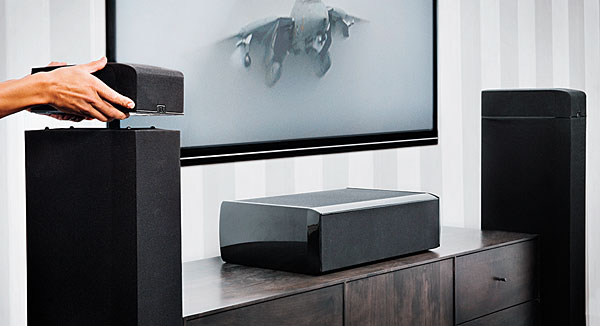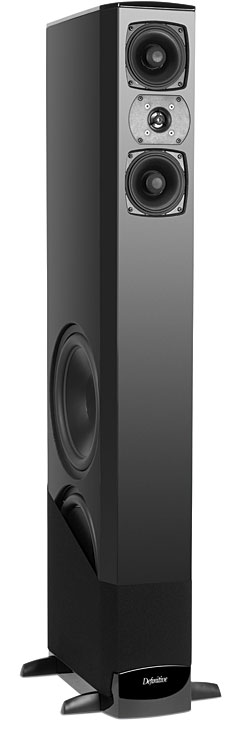I have a 5.1.2 Atmos setup with 8060/A60's in the front, 8040hd center, and def tech in-ceiling rear surrounds, with the Pioneer Elite SC-85 Atmos receiver. My setup sounds terrific, and the Atmos height effects are amazing, especially with helicopters and planes flying overhead. I agree the 8060's sound great for both music and movies, just wondering why not 5 stars for performance?
Definitive Technology Atmos-Enabled BP-8060ST Speaker System Review Page 2
Music and Movies
After my customary week or so of daily casual use to obviate any break-in issues, I began as usual with critical listening to the BP-8060STs alone, in stereo direct mode. As I fully expected from past encounters with this speaker, I was impressed by just how closely the towers cleave to my idea of correct tonal balance. The BP-8060STs are marginally warmer than my everyday, stand-mount, three-way monitors and, of course, go a good half-octave lower (or better). But otherwise, they are very, very, very close on timbre.

I tend to look to deeper male vocals for a hot read of loudspeaker midrange. On the classic “Walk on the Wild Side,” the late Lou Reed’s slightly nasal baritone came across spot on, with just the slightest addition of heft; at the same time, every element of this remarkably well-recorded track was intact and properly proportioned. The BP8060STs’ bipole repro pattern has a natural tendency to accentuate, very slightly, the spatial content of even plain ol’ stereo. I could hear this very clearly on “Walk,” especially when the, umm, girls’ backup doo-didoos fade in while simultaneously cross-fading from reverb to dry (it’s a classic production moment).
Reed’s voice on this track is a hard-centered, dryly recorded “in-the-room-with-you” element, a sharp contrast to the space-traveling backups. The Definitives maintained this nicely, but their bipolarity added a slightly broader/deeper sense, for a less sharply focused effect. It’s quite subtle but easily heard when you A/B the towers against direct-radiating speakers of similar character. I stamp it as neither good nor bad, merely different, a characteristic that comes with the bipolar territory.
Regular readers know I’m not a big fan of direct-radiating surround speakers aimed at the listener—at least for movies, where I prefer a dipole’s ability to enhance spatial ambience while reducing localization tendencies. For multichannel music, however, most producers and mixers (at least pop/rock ones) prefer a setup like our Def Tech suite, with four identical, full-range speakers in the corners. After spinning the surround version of Tom Petty and the Heartbreakers’ Mojo (in DTS-HD Master Audio, on the album’s Blu-ray edition), I can see why. The wraparound distribution of Mike Campbell’s guitar fills was convincing, as was the lifelike short-delay, small-space studio ambience on a track like “Running Man’s Bible.”
 A word about bass: With four BP-8060STs, there’s plenty of it, and enough to spare. Pop bass guitar like the T.P. disc’s had clean, visceral power like you get when you stand next to an Ampeg stack on stage. And when I cued up Transformers: Age of Extinction for a sampling, Holy Mother of God! Pounding drums, earth-shaking crashes, gut-stirring lows—and that was just the disc menu. (Bada-bing!)
A word about bass: With four BP-8060STs, there’s plenty of it, and enough to spare. Pop bass guitar like the T.P. disc’s had clean, visceral power like you get when you stand next to an Ampeg stack on stage. And when I cued up Transformers: Age of Extinction for a sampling, Holy Mother of God! Pounding drums, earth-shaking crashes, gut-stirring lows—and that was just the disc menu. (Bada-bing!)
As I got into the film, I had to dial back the four towers’ woofer-level controls a touch to tame a window rattle, even though I was playing 6 dB or so below reference level and hadn’t had a rattle problem in years. This points out one more valid argument for the line-level subwoofer-connection option, at least for the front pair: By this route, you would gain remote-control access to overall woofer level (via the A/V receiver/processor) and might choose to preset different woofer-level setups for music, movies, TV, and so on. A corollary benefit to this arrangement is the option to underlap crossover settings as previously discussed, thus highlighting the Definitives’ excellent deep-bass qualities while de-emphasizing the next octave a tad, which is generally how I like things.
Played via two channels at truly absurd volume settings, a pitched program with excessive sub-35-Hz content (in other words, dubstep) could induce a bare hint of woofer or passive-radiator chuffing. But I had to hear it first naked (woofer sections playing alone) to be able to pick it out full-range.
Along the same lines, with my everyday 150-watt-per-channel power amplifier, supplemented by the Definitives’ four 300-watt-rated woofer amps, the four towers readily achieved truly foolish levels without obvious distortion. And this remained true even with the somewhat less powerful Denon A/V receiver I used for the Atmos auditions below. The BP-8060STs are quite sensitive and seemed a benign load, so big power isn’t necessarily required.
The Transformers Blu-ray is the only full-length Dolby Atmos disc I currently have, and was, at the time of this writing, the only one available. As you might guess, it’s a super-surround-intensive production. As I’ve already said about Atmos (again, see “Atmos, Here,”), it works, impressively, adding a genuine verticality and an airier, more open, slightly brighter overall surround presentation. (Exploiting the Def Techs’ Atmos abilities required an Atmos-capable receiver; I used the Denon AVR-X5200W). It’s early days yet, but I think I’m going to be a fan.
The A60 Elevation Modules integrated admirably, sound-wise, with the BP-8060STs. The movie clips from Dolby’s August 2014 Atmos Demonstration Disc delivered gob-smacking, up-over-and-around placement and movement, and with never a hint of point-source speaker localizing, for beautifully naturalistic ambience.
What’s more, at least in the Def Tech towers’ case, Atmos went a good way toward mitigating the closeness and directness of having tower surrounds a mere 5 or 6 feet from my ears. Even on non-Atmos material, when I engaged the Denon’s “+ Atmos” mode (which appeared to send derived surround-height signals to the four A60s), both the spread and the enlarging feel of surround ambience in all directions were quite notable. It also added a very slight brightness to the surround bubble, but in a positive, lifelike way.
Fifty-six and change is a lot of money for a surround speaker system, but the Definitive suite as reviewed here—all nine pieces of it—is a whole lot of loudspeaker, especially for those who favor loud and clean. And should Definitive bow a non-powered bipolar Dolby Atmos-enabled model, which I’d hope they would, I wager you’ll be able to shave a good chunk of that money at little if any sonic cost and just add a subwoofer or two. You do need to have a good deal of fore-and-aft room to place these towers well off the front wall, you won’t want to stray too near a corner, and you’ll need AC power to each speaker. Otherwise, this is a one-stop, fullrange, state-of-the-surround solution. I heard nothing but good things from it, and I return the favor.
- Log in or register to post comments


I had a def tech system of 4- 2006's and the 2500 C/L/R for about 3 years and I was never happy with it. If I had a penny for how many times I re-arranged it I'd be a millionaire. Perhaps it was my room that is 12X14 with 8' ceiling and 2 windows, a french door, and open alcove into the kitchen, plus a tiled floor. I'm surprised my wife didn't divorce me:). I finally went back to my old Atlantic Tech. satellite system with 2 subs. The difference was night and day. Ultimately I sold the Def Techs. and bought a new Pioneer Elite VSX52 receiver. I know I lost money on the deal but just wanted to get rid of the def techs. BTW re: VSX-52 this is one receiver that runs hot, and not the first Pioneer to do so. My solution was to install a laptop cooler pad on top of the receiver connected to my tv. Problem solved. The other night I temp. removed the pad and cranked up Pacific Rim (7.1). Fifteen minutes later the receiver was absolutely hot (not warm) to the touch. And the receiver placement is not enclosed in a cabinet.

pass4sure HP0-S45 - I agree with you. This post is truly inspiring. I like your post and everything you share with us is current and very informative. You done a fantastic job.- pass4sure C_TFIN52_67




































































